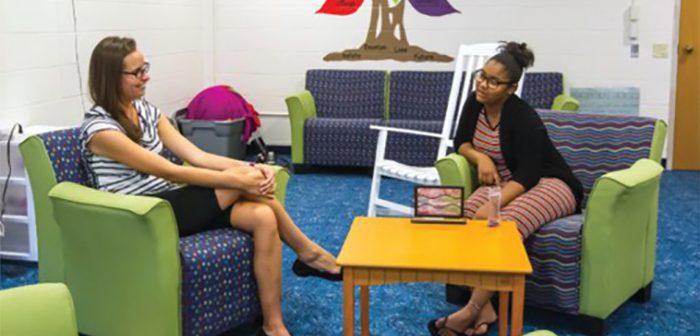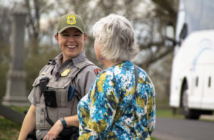Hoffman Homes Provides TLC (Therapeutic Loving Care)
for Pennsylvania’s Children
By Cheryl Sobun | Photography by Casey Martin
If George and Agnes Hoffman of Littlestown were alive today, they would be pleased to know that for 106 years, thousands of children have lived, laughed, and played on their property. The Hoffmans loved children but never had any of their own. The couple’s final wish was for their 192-acre farm to become an orphanage after their death.
Hoffman Homes for Youth opened its doors on July 27, 1910, and it remained an orphanage until the modern foster care system made such places obsolete. Hoffman Homes changed with the times in 1960 and became a residence for juvenile delinquents and dependent youth with mental health problems. The third and final change came in 1990 when Hoffman Homes became what it is today, a psychiatric residential facility for children.
At first glance, the Hoffman farm looks like any other. However, it’s dotted with 17 buildings—nine residences, a chapel, a school, and others, making it look more like a college campus. The children live here, go to school here, but most importantly, they receive round-the-clock care from a staff of mental health workers who teach the children lifelong skills they need to live happier, healthier lives.
A Safe Haven for Children
Hoffman Homes embraces the Sanctuary Model of treatment and just became Sanctuary® Certified in May. Kris Roeder, vice president of marketing and development, says the Sanctuary Model “offers communication and trust without judgment, and questioning without blame. By asking our children, ‘What’s happened to you?’ instead of ‘What’s wrong with you?’ for example, we empower them to safely express themselves and find the help and encouragement they need for healing and recovery.” Also, “because of their special needs, these children benefit from a living and school environment that is highly structured, rich in therapeutic programming, and supported by a specially trained staff.”
According to Hoffman Homes’ literature, “We dedicate ourselves to being a safe haven for children who are psychologically and emotionally at risk, and we seek to provide a safe, healing, homelike, accessible environment for all children in our care. To that end, in addition to an onsite day school and traditional therapies, we offer a full range of creative therapies, including art, pet, and therapeutic horsemanship.”
These creative therapies are exactly what one mother found so attractive, she bypassed five facilities much closer to her home in Chester County, Pa., so her son Cameron could go to Hoffman Homes, two hours away.
Around the age of 3, Cameron began having “outbursts and meltdowns,” says his mother, Melissa Harrop. He was diagnosed with autism spectrum disorder and disruptive mood dysregulation disorder at age 5. The family first struggled with outpatient help because “you want the child at home. You want to work as a family to get them where they need to be,” says Harrop.
But, that changed last October. “He attacked a [school]bus driver, which is why we had to hospitalize him,” says Harrop. “We didn’t want the police involved, but we didn’t want people to get hurt.”
Cameron remained in a psychiatric hospital for two months while he was on a waiting list for Hoffman Homes, which can comfortably accommodate about 90 children at a time. Cameron had just turned 10 when he was admitted to Hoffman Homes and was given a nine-month treatment plan, as most children receive. He is doing so well, however, he will be released after just seven months, his mother says.
The family noticed the change in their son immediately. Just three months into Cameron’s treatment, the family got to take him out on a day pass. The family—mom, stepfather, older brother, younger sister, and Cameron—spent the day in Gettysburg and lunched at Perkins.
“Normally, we couldn’t take Cameron to a restaurant or a place with a lot of people,” Harrop says. He would become anxious and excitable around crowds. This time when he started to get anxious, Harrop told him he needed to calm down—a command that usually prompted Cameron to revolt, but “they taught him at Hoffman how to calm himself down. He started doing deep breathing and counting to 10, forwards once and backwards once. He literally calmed down on his own, with us just saying one thing. In the past, he would have acted out, gotten angry with us. I had to leave to go to the bathroom, and I started to cry [tears of joy]synthroid price.”
It’s a Family Treatment
Cameron and the other children, ages 5-18, at Hoffman Homes are enrolled in a school curriculum that is approved by the Pennsylvania Department of Education, with a typical, 180-day school year, says Walt Smith, director of education/vice president of educational services. What is not typical, however, is there are always two or three adults in the classroom—a special education teacher, a teacher’s aide, and a trained mental health worker—and the classrooms are very small, usually eight to 10 children, and never more than 12.
Harrop says Cameron especially enjoys the creative therapies that attracted them to Hoffman Homes in the first place. Being with the animals, for example, has helped Cameron stay calm and control his emotions, she says, while art therapy allows him to express his feelings.
Harrop’s biggest surprise: “I wasn’t expecting that I was going to learn so much. We anticipated Cameron’s being the one in treatment and learning the coping skills and social skills, but I found I have learned so much as well…It’s a family treatment; it’s not just the child.
It was the best place for Cameron but also for us as a family.”
Children receive discharge plans, so they can continue living the life they learned at Hoffman. Harrop says they are going to be setting up a Sanctuary Model at home, and Cameron will be starting fifth grade in the fall, an emotional support elementary school back home. She says there was a lot of “fighting” with the school district to get Cameron in the special school because of the cost involved, but Hoffman Homes advocated for them.
“It doesn’t amaze me that [Hoffman Homes] would do that. They went to bat for me, and they went to bat for Cameron…I think they’ll always be there for us,” says Harrop.
Hoffman Homes is not free. It’s a private nonprofit, so it relies largely on fundraisers, donations, and grants. Private health insurance and Medicaid pay for most of the residents’ care, says Mitch Snider, CEO and president of Hoffman Homes, but incidentals such as haircuts, eye glasses, shoes, dental services, clothes, van rides to area churches, and more, are not covered. The next big fundraiser is the Annual Gala & Dinner on Friday, Nov. 4, from 6:30-10:30 p.m., at the Hanover Country Club, 200 Water St., Abbottstown. Tickets are $75 a piece, and there will be a silent and live auction.
Harrop says she and her family now feel like part of the Hoffman Homes family, and Cameron wants to be involved in fundraisers in the future including a 5K fundraiser next year. “Hoffman is not the place where the bad kids go,” Harrop says. “It’s a place where they really help kids. They’re people that I know really care about what they do. It’s not just a job. They live that Sanctuary Model. For all they do for the kids and for the families, they are like angels.”
According to the National Center for Health Research, children’s exposure to companion animals can help ease anxiety. That’s why pet therapy and therapeutic horsemanship are just a few of the offerings at Hoffman Homes for Youth, where children receive round-the-clock care from a team of mental health workers and teachers.
For more information about Hoffman Homes for Youth or upcoming fundraisers, visit
www.hoffmanhomes.com.




